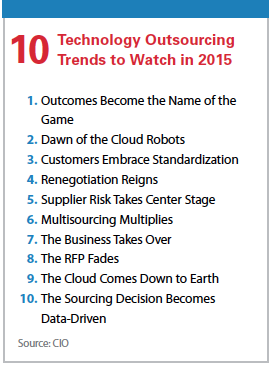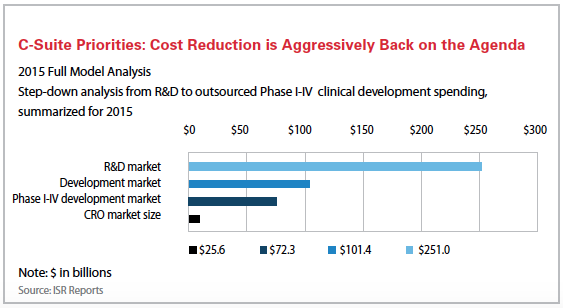Companies continue to examine new ways to optimize operations and capitalize on efficiencies through partnerships.
As the industry continues to move to a more patient-centric model, which encompasses all aspects of the continuum from R&D through commercialization, CROs and other service partners are redefining their outsourcing models — hybrid, strategic partnership, functional, etc. — as a way to bring more value and expertise to the partner table.
Analysts at ISR Reports contend that the pace of change in the CRO market will not slow down anytime soon. They expect the trends to be similar to what is happening on the manufacturing side of the business, they expect that there will be more mergers as providers continue to scale up global capabilities and fill in their service offerings. They also say there will be more sophisticated marketing and branding efforts as the battle for market share increases. Finally, they say to expect “nontraditional" CRO service providers to enter the market via partnerships or outright acquisitions.
similar to what is happening on the manufacturing side of the business, they expect that there will be more mergers as providers continue to scale up global capabilities and fill in their service offerings. They also say there will be more sophisticated marketing and branding efforts as the battle for market share increases. Finally, they say to expect “nontraditional" CRO service providers to enter the market via partnerships or outright acquisitions.
ISR analysts say pharma and biotech R&D spending will remain relatively flat, adding that there certainly will be ups and downs in VC funding and there likely will be a shift toward more biotech product R&D. In addition, they don’t see the split between the R and the D moving much, nor do they see the percentage of Phase I-IV development spend shifting much. That leaves the outsourcing penetration as the major lever for total CRO revenue growth. For example, they say to expect a 3% point increase in outsourcing over the base model, which would translate into the CRO market size moving from $25.6 billion to $27.7 billion in 2015.
Driving some of this increase could be a move to a true strategic partnership model, which has been identified in a recent Paraxel report as an effective biopharmaceutical outsourcing model to meet key sponsor needs.
The model is considered particularly effective in enabling greater cost predictability, strategic management of the R&D portfolio, and management of capacity gaps.
Among companies surveyed, more than half use a strategic partnership model: 54% of North American biopharmaceutical companies engage in strategic partnerships, while 50% in Europe and 53% in Asia now use this approach.
Positive perceptions of outsourcing effectiveness within the biopharmaceutical industry have increased significantly in the last three years: This increase has occurred across all geographies and with sponsors of all sizes.
A 2013 study from the company revealed 85% of biopharmaceutical executives surveyed believe strategic partnerships have positively impacted CRO-sponsorship relationships.
Analysts from TechNavio also predict that the CRO market is positioned to grow, citing a CAGR of 9.83% from 2014 to 2019.
Increased R&D by biopharmaceutical companies is one of the major trends emerging in the market. Customers are increasingly opting for biopharmaceutical drugs rather than chemical pharmaceuticals drugs for the treatment of some diseases, such as diabetes, cancer, and genetic diseases because biopharmaceutical drugs offer several advantages.
According to the report, increased outsourcing of R&D activities by global pharmaceutical and biopharmaceutical companies is one of the main drivers of the market. Several tier I and tier II pharmaceutical and biopharmaceutical vendors are outsourcing R&D and clinical trial activities to CROs to reduce their expenditure on R&D activities.
On the flip side, the report states that the shortage of experienced personnel to conduct various activities in CROs is one of the main challenges in the market. Moreover, many CROs do not have sufficient personnel to fulfill the R&D demands of their manufacturing partners.
 Even with some of the challenges in the CRO marketplace, ISR reports that as of December 2014, the publicly traded CROs — for example, Quintiles, Parexel, INC, PRA — added a combined $14 billion to the market in the prior two years.
Even with some of the challenges in the CRO marketplace, ISR reports that as of December 2014, the publicly traded CROs — for example, Quintiles, Parexel, INC, PRA — added a combined $14 billion to the market in the prior two years.
When it comes to the strategic portion of the relationship, KPMG found that manufacturers are looking for cost savings as a key factor, noting that cost reduction is aggressively back at the top of the C-suite agenda. Additional insights include a very strong C-suite interest in end-to-end process optimization, analytics, robotic process automation, and other technology enablement to achieve sustainable improvement.
Conversely, only one-third of outsourcing buyers see current relationships delivering significant value, the vast majority of these buyers view service provider collaboration, integration, and accountability as a means to drive value. (PV)
~~~~~~~~~~~~~~~~~~~~~~~
Executive viewpoints
 Michael Griffith
Michael Griffith
Executive VP,
inVentiv Health
President, inVentiv Health Commercial
Commercializing Assets
To win in today’s complex, global marketplace, clients must rethink how they commercialize assets. They must consider ways to improve existing commercial practices and find a model that is more flexible, scalable and innovative. Clients need a comprehensive commercialization model that integrates strategic, creative and operational expertise as never before to help clients optimize performance, reduce risk, and expedite delivery of healthcare innovation to patients worldwide. Such a model, which is new to the marketplace, brings real, increased value to pharmaceutical companies.
Creating the Right Complement of Capabilities
Outsourcing comprehensive commercialization to the right provider offers instant access to global reach, broad therapeutic expertise, and premium services. Global companies can find complementary expertise, high-value strategic insights, and essential speed. Emerging innovator companies can find full commercialization capabilities that allow them to retain the value of their assets. Very few companies can offer such a broad range of services, but clients can benefit most from those that do.
 M. Clareece West
M. Clareece West
Chief Operating Officer
MedNet Solutions
The Keys to a Successful Outsourcing Relationship
Over the years, I’ve witnessed firsthand numerous outsourcing models — all promising to “save clients time and money." Not to be cynical, but while it’s easy to talk about potential outsourcing savings, it’s not always easy to deliver on those promises. Keys to moving from a “contracted vendor" relationship to a “trusted and valued long-term partnership" include: written partnership charters, outlining goals, responsibilities, and assumptions; transparent communications at every level; documented strategic technology implementation plans and goals; and strategic outsourcing evaluations focused on relevant, quantifiable metrics.
 George Esgro
George Esgro
VP Head US Commercial Sales
Quintiles
Hybrid models offer flexibility to meet changing needs
Strategic resourcing offers flexibility to adapt to rapidly evolving market conditions, recover quickly from unanticipated events, and focus on the core portfolio. This allows rapid decision-making and implementation, with capacity to tailor resources depending on lifecycle stage and market conditions. Hybrid delivery models, such as integrated channel management to physicians, combine e-solutions and traditional channels into a customized, cost-effective communications mix. This can be monitored and optimized in real time, across all channels, helping drive cost-effective growth throughout a product’s lifecycle.
 Beth Price
Beth Price
Executive VP
The Medical Affairs
Company (TMAC)
A Hybrid Client-Centric Model
As companies come to recognize the value of utilizing external support for critical functional medical affairs activities, demands for expanded services in this area call for outsourced medical affairs service providers to offer more scalable, flexible and expanded options targeted to a broader constituency group. Hybrid models utilizing blends of both internal and external resources are increasingly in demand for companies seeking to create this balanced capability. The need for expanded outsourced medical affairs options includes consultative services, strategic planning, flexible management models, policy development, team sizing and alignment, and training of field medical personnel. As a result of these new demands, service providers must adjust their offerings to remain client-centric.
 Lou Shapiro
Lou Shapiro
Senior VP
Tunstall Healthcare Group
Competencies and Gaps
When adopting a new outsourcing strategy, there are two things companies need. The first is a clear outline of the skills and requirements needed for success. The second is to identify internal competencies and gaps versus the skills and requirements needed for an initiative to be successful. When evaluating potential outsourcing partners, look at their expertise and ability to fill the gaps identified. Equally important is culture; take the time to evaluate how well your team can work with their team. High-functioning teams accomplish goals.
Technologies and Innovations
To fully leverage rapidly advancing technology and innovations, companies and outsourcing partners must establish ongoing and open communications about the future vision and plans for initiatives. Outsourcing partners typically closely monitor technology innovations and will invest in new technologies when a measurable improvement or significant new functionality is available that will benefit the initiatives.
~~~~~~~~~~~~~~~~~~~~~~~~~~~~


















